Ijraset Journal For Research in Applied Science and Engineering Technology
- Home / Ijraset
- On This Page
- Abstract
- Introduction
- Conclusion
- References
- Copyright
Face Recognition Based Biometric Identification System with COVID-19 Detection
Authors: Salila Hegde, Nandini M S, Rahila Samar, Ramyashri H N
DOI Link: https://doi.org/10.22214/ijraset.2023.49319
Certificate: View Certificate
Abstract
In this paper face recognition system for the purpose of security is explored whose design is based on Raspberry Pi system. An add on temperature detection system also gives detection of COVID affected people. With the COVID-19 pandemic, temperature checking before you enter a premise is a necessary step to ensure you are well and help keep others safe. One of the most common ways is to use a handheld digital thermometer to find out your own temperature and recording it on some kind of logbook placed near the front door. For a workplace, employees are encouraged to record their temperature twice a day.
Introduction
I. INTRODUCTION
Face recognition systems are capable of detecting faces from nearby and far off places. This is achieved mainly by two ways; one is through sophisticated camera and other is through trained ML algorithms which can process the input image from camera and recognize faces in real time. Many features such as gender recognition, age detection, and live face detection can be included to train algorithms-1-7].
Yang etal. [8] proposed face detection based on human knowledge and set of rules. The approach is feature invariant, which locates the face by extraction of structural features. A trained classifier is used to discriminate non facial and facial regions.
Turk and Pentland [9] proposed a face detection method wherein the dimensionality of face model is decreased from size of pixel to principal basis.
This principal basis contains sufficient information in the encoded form. This methodology best preserves the data in embedding space, but suffers in discriminating capability.
Belhumeur and coauthors propose face detection by dimensionality reduction based on linear discriminant analysis (LDA) [10]. Their method improved face discrimination but performs poor in face verification.
Dominik Schiller and coauthors developed a facial expression recognition model that makes use of saliency maps [11]. The non-relevant information is hidden while transferring knowledge from an arbitrary source to destined network. This method is independent of model employed because the experience is solely transferred via input data augmentation.
Masi et al. propose presented methods to improve realistic datasets with critical facial types [12]. Faces in the list of datasets are controlled along with convolutional neural systems to coordinate inquiry pictures
In the recent times of COVID, the feature to recognize masked and unmasked faces also been developed. Our goal through this project is to explore the feasibility of face recognition system implementation on Raspberry Pi based system and detect if that person belongs to the same institution. Display his/her present status and then followed by auto detection of body temperature of human body for COVID-19 detection.
This paper explores the face recognition system using Raspberry Pi based system and detects if that person belongs to the same institution/organization.
To display his/her present status and then followed by auto detection of body temperature of human body. High quality camera is useful in capturing clear images of object. Low lighting can cause hinder in getting a good image input.
The algorithms trained by images should be from different angles, with makeup and without makeup, faces with spectacles so that two different faces of same person should not confuse the algorithm and produce errors. This might cause huge problems when it comes to recognition for criminal offenses cases and defence related security cases. Liveness of input feed can be manipulated using makeup which can fool the system to grant access.
II. METHODOLOGY
Figure 1 depicts the block diagram of the proposed method for face detection and temperature sensing for COVID-19 detection.
- The Pi camera module which is 5MP connected to Raspberry Pi will take input video stream.
- The OpenCV module is a computer vision library built on C/C++ backend and is trained with millions of images.
- The frontal Haar cascade weight file is specifically trained with faces and is a pre trained weight file.
- This file is trained with real-time faces of students and their information fed in.
- Preprocessing of face image is done as shown in figure 2.
- Each face will have its own calculated value which compared with the threshold to give an accuracy percentage.
- Faces detected with accuracy of more than a threshold value will be given access. The rest is denied.
- Post the face recognition, the contactless temperature sensor checks for the temperature of the student and records the same in to the database.
- Only if a face is recognized and temperature is below the threshold, the access is allowed. And this is given output by a speaker.
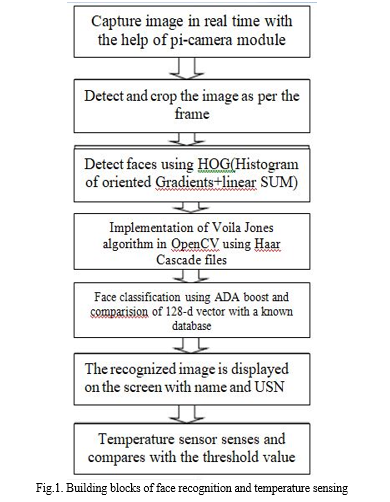
The user application will have following features:
- To add new faces.
- To show the registered student information.
- To show the daily attendees and registered users.
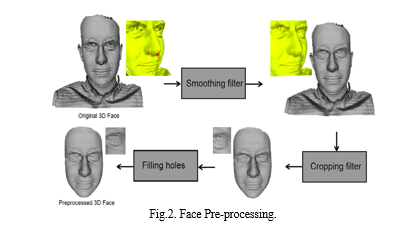
A. Design Implementation
- An Image of size 64×128 with aspect ratio of 1:2 is considered and Histogram of Oriented Gradient (HOG) descriptor is found using below formulae.

2. Where gx,gy,g and θ are horizontal and vertical gradients, magnitude and direction of gradient respectively
3. Image is divided into 8×8 segments and a histogram of gradients is found for each of these 8×8 segments. An 8×8 color image segment
4. Has 8x8x3 = 192 values. The gradient of this segment has two values (magnitude and direction) per pixel, hence total 8x8x2 = 128 numbers.
5. These 128 values are represented using a 9-bin histogram which is stored as an array of nine numbers. Histogram of these 128 numbers is a vector of 9 bins which correspond to angles o 0, 20…160.
6. Based on the direction a bin is selected and based on the magnitude a vote is selected.
7. Pixel which is encircled in Blue color in figure 3 has magnitude of 2 and an angle of 80 degrees. Hence it adds two to the histogram bin. Pixel which is encircled in Red has magnitude of 4 and angle of 10 degrees. The vote for this pixel is split between the two bins.
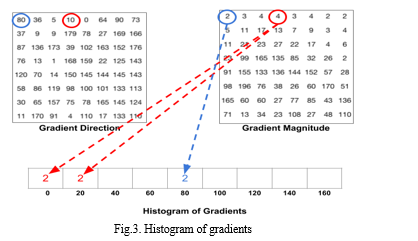
8. All the pixels in the 8×8 segments contribute to make 9 bin histogram as shown in figure 4.
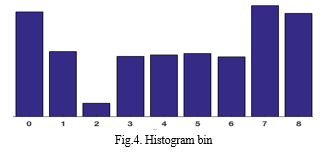
B. Face Detection Algorithm
Viola-Jones Face Algorithm uses boosting technique which is machine learning algorithm. In this feature selection is done by each feature evaluation using its value. Viola Jones classifier is also called as Haar cascade classifier which has following 4 stages;
- Selection of Haar features
- Creation of Integral Images
- Adaboost Training
- Cascading Classifiers
- Haar Feature selection
- Kernel used is similar to convolution kernel and it is used to detect the required feature in the image as shown in figure 5.
- Sum of pixels under white area is subtracted from the sum of pixels under black area to arrive to a value for each feature.
- Base window of size 24x24 is used and evaluation of feature value starts in any given image.
- Approximately 1,60,000 and odd features will be found by considering all possible Haar feature parameters like scale, type and position.
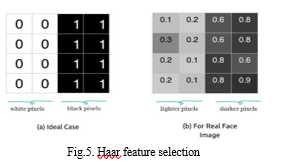
2. Creation of Integral image
An integral image helps significantly to reduce time and power to process large number of features in an image in real time.
- Integral Image is formed by adding top left and bottom right pixel values to the pixel of interest.
- This process is as shown in figure 6.
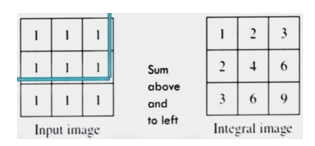
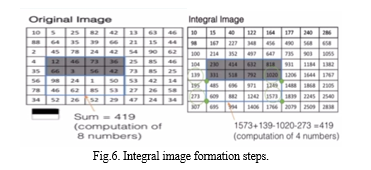
3. Adaboost
- Out of these 1,60,000+ values only few sets of values will be useful.
- This machine learning algorithm finds only the useful features among 1,60,000+features.
- Adaboost forms a classifier which is strong because it is the linear combination of weak classifiers shown in figure 7.
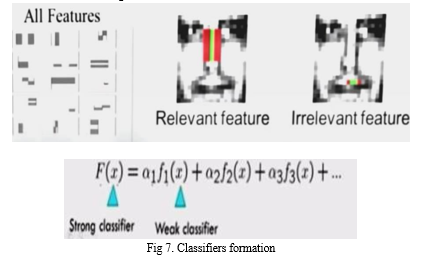
4. Cascade classifiers
- The algorithm spends significant time on most probable face regions by discarding no face regions.
- The cascade classifier used has multiple stages, where each stage has a strong classifier. Hence all the features are clubbed to form group of several stages. Each of the stage has some specific number of features.
- Every stage finds whether a given sub window is a definite face or not. not. If the given sub window fails in any of the stage, then it is discarded without wasting time. These steps are depicted in figure 8.
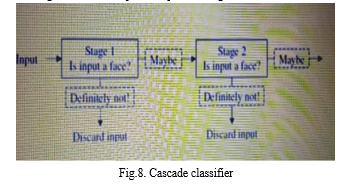
III. FLOW CHART
5. Steps of flow
- Acquiring new image from camera and convert color (RGB) image into gray –scale which consists of 0's and 1'swhich is used for ease of processing an image and then detects eyes in a face image with cascade classifier which is trained with several hundreds of positive samples of images.
- The trained classifier can be applied to detect the object in question in the given face image.
- Then we go with Normalizing face images size and orientation with constant image size, fixed eye positions, frontal orientations with help of clipping, rotating and scaling the image.
- Then contrast and lighting enhancement followed by face recognition with help of PCA Classifier.
- If a set of images is visualized as a set of co-ordinates in a high-dimensional data space then PCA can provide the user with a lower dimensional picture which is used for face recognition, then face samples are collected and recognition is done. Here we use Haar Cascade with open CV library, in which repository of pre-trained Haar cascade classifiers is maintained. The flowchart is as shown in figure 9.
Flow chart is continued in next page also.

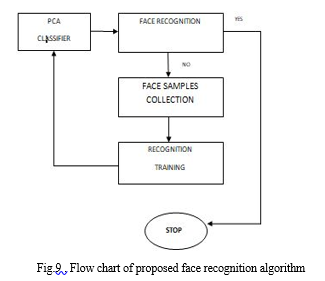
IV. FACE RECOGNITION RESULTS
The face recognition and temperature detection system as proposed in our project will result as a very useful system in our society and meet the expectations ensuring the safety and control during this pandemic.
Live face detection and recognition results are as follows:
Firstly we implemented facial recognition on the database/ reference images as show below in figures 10 to 15. for three separate images namely RAHILA,FIZA and RAMYA who were our students and staff.
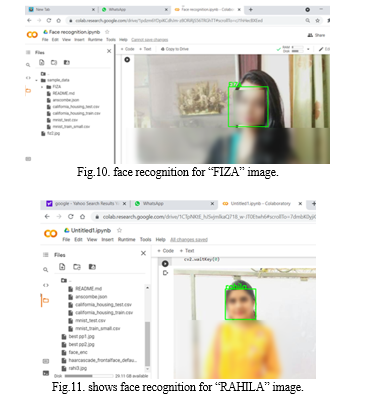
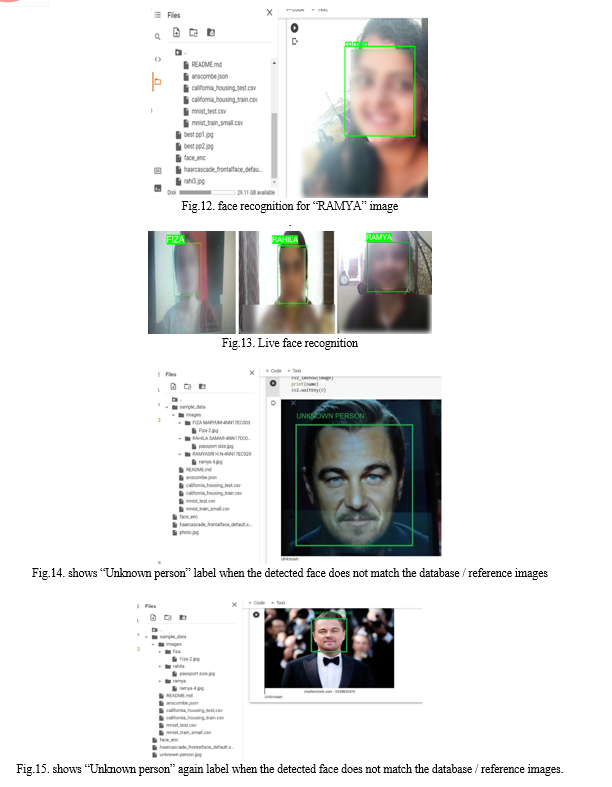
V. TEMPERATURE SENSING
After the face is detected the system follows auto temperature detection process Due to COVID 19 impact, the number of users allowed in a particular room in offices, shops, etc. was restricted. The face detection algorithm allows only a predetermined person to the room. The entry of the person in the restricted room is detected with the help of laser diode and a receiver as shown in figure 16. Once the entry is detected the temperature of person is sensed. If the temperature is less than the preset threshold the person is allowed to enter, otherwise denied.
Infrared Thermometer Sensor - MLX90614 is used for sensing the temperature of the body [13-14].
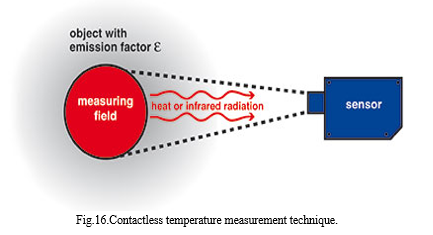
The MLX90614 has two types of output. The PWM output is 10 bit and has resolution of 0.14°C, while the output provides a resolution of 0.02°C. It has following features. This device comes in an industry standard TO-39 package. We're carrying the 3V version of this sensor.
- Low cost and small size
- Integration is easy
- Following wide temperature range which is factory calibrated
- for sensor temperature:-40 to +85°C
- for object temperature:-70 to +380°C
4. digital interface which is SMBus compatible
5. 10-bit PWM output for continuous reading.
6. High accuracy of 0.5°Cover wide temperature range
7. Measurement resolution of 0.02°C
8. Can be adapted to 8 to 16V applications
9. Works in power saving mode
We are using 3V version of this sensor.
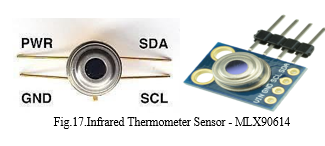
VI. TEMPERATURE SENSING RESULTS
A large number of people entry can be evaluated as The non-contact temperature sensor can make quick measure and display. The use of non-contact temperature sensing devices is a boon to reduce the risk of COVID-19 spread and infections and requirement of cleaning is also minimal. The test result sample images are as shown in figures 18 to 22.
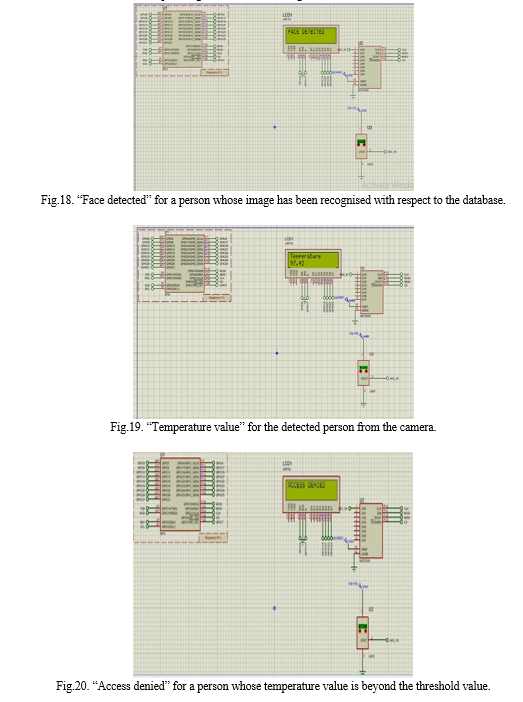
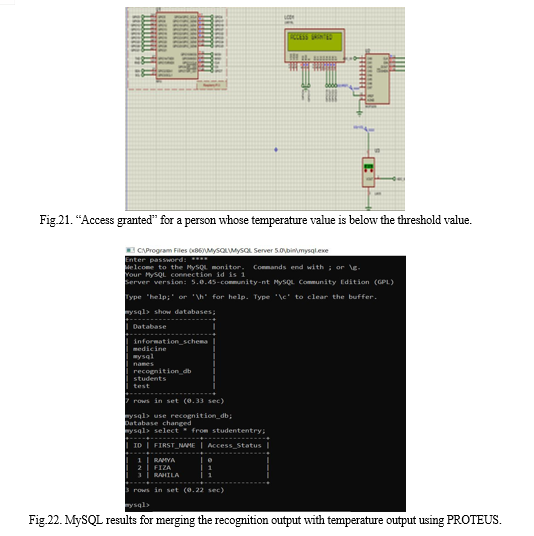
VII. SCOPE AND FUTURE WORK
The scope of this project is promising. Face detection and recognition will prove to be a boon to many high profile organizations like banks, educational institutions and other big companies wherein the security of confidential documents is highly required and entry of any unauthorized person into the organization could lead to theft, and other major security issues which would affect the whole and soul of the company and hence, allowing only the authorized and recognized people inside the building is very much necessary and this project does exactly that. It ensures the security and helps in maintaining the confidentiality of the organization.
Conclusion
This paper proposes an implementation of face recognition and temperature detection system. During capturing and training phase several positive and negative images are created. The design is implemented in Analog and Digital Labs, EC Department, NIEIT, Mysore. Test image samples of students and staff are captured during training phase. “FACE DETECTED” or “FACE NOT DETECTED “status is obtained on terminal during test phase. After that temperature is sensed and Access is tested. This is a low cost device and useful in COVID-19 like situations at Colleges, Universities, Hospitals etc.
References
[1] M. Kasiselvanathan, Dr. A. Kalaiselvi, Dr. S. P. Vimal, V. Sangeetha, “Smart Attendance Management System Based on Face Recognition Algorithm”, International Journal of Pure and Applied Mathematics Volume 120 Number 5, 2018. [2] M. Krišto, M. Ivanic-Kos, “An Overview of Thermal Face Recognition Methods”, Proceedings of Asian Biometrics Workshop. Singapore, May2018. [3] Nandhini R, Duraimurugan N, S. P. Chokkalingam, “Face Recognition Based Attendance System”, International Journal of Engineering and Advanced Technology (IJEAT) ISSN: 2249 – 8958, Volume-8, Issue-3S, February2019. [4] Nirmala Kar, Mrinal Kanti Debbarma, Ashim Saha, and Dwijen Rudra Pal, “Study of Implementing Automated Attendance System Using Face Recognition Technique”, International Journal of Computer and Communication Engineering, Volume 1, Number 2, July2012. [5] Piyush Devikar, “Face Liveness and Disguise Detection UsingRaspberryPiandOpenCV”, InternationalJournalof Innovative Research in Computer and Communication Engineering (IJIRCCE), Volume 5, Issue 1, January2017. [6] Smitha, Pavithra S Hegde, Afshin, “Face Recognition based Attendance Management System”, International Journal of Engineering Research & Technology (IJERT), Vol. 9 Issue 05, May-2020. [7] Vaishali M. Bodhe, Sagar M. Bhakre, Sneha D. Ikhar, “Student Attendance System by Face Detection”, International Journal of Innovative Research in Computer. [8] Ming Hsuan Yang, J.Kriegman,Narendra Ahuja, “ Detecting faces in Images : A survey”, IEEE Transactions on Pattern Analysis and Machine Intelligence, Vol.24, N0.1, Jan-2022. [9] M. A. Turk and A. P. Pentland, \"Face recognition using eigenfaces,\" Proceedings. 1991 IEEE Computer Society Conference on Computer Vision and Pattern Recognition, Maui, HI, USA, 1991, pp. 586-591, doi: 10.1109/CVPR.1991.139758. [10] Peter N. Belhumeur, Joao~ P. Hespanha, and David J. Kriegman, “Eigenfaces vs. Fisherfaces: Recognition Using Class Specific Linear Projection”, IEEE Transactions on Pattern Analysis and Machine Intelligence, Vol.19, N0.7, Jul-1997. [11] Dominik Schiller, Tobias Huber, Michael Dietz, Elisabeth André,” \"Relevance-based data masking: a model-agnostic transfer learning approach for facial expression recognition\", Frontiers in Computer Science, Vol.2, Article 6, Mar-2020. [12] Iacopo Masi, Anh Tuan Tran, Jatuporn Toy Leksut, Tal Hassner, Gerard Medioni, “Do we really need to collect millions of faces for effective face recognition?”, Computer Vision and Pattern Recognition, APR-2016 [13] Gang Jin, Xiangyu Zhang, Wenqiang Fan, Yunxue Liu and Pengfei He, “Design of Non-Contact Infra-Red Thermometer Based on the Sensor of MLX90614, The Open Automation and Control Systems Journal, 2015, 7, 8-20. [14] Gonçalo Marques and Rui Ptarmic, “Non-contact Infrared Temperature Acquisition System based on Internet of Things for Laboratory Activities Monitoring”, Elsevier, Procedia Computer Science 155 (2019) 487-494
Copyright
Copyright © 2023 Salila Hegde, Nandini M S, Rahila Samar, Ramyashri H N. This is an open access article distributed under the Creative Commons Attribution License, which permits unrestricted use, distribution, and reproduction in any medium, provided the original work is properly cited.

Download Paper
Paper Id : IJRASET49319
Publish Date : 2023-02-28
ISSN : 2321-9653
Publisher Name : IJRASET
DOI Link : Click Here
 Submit Paper Online
Submit Paper Online

